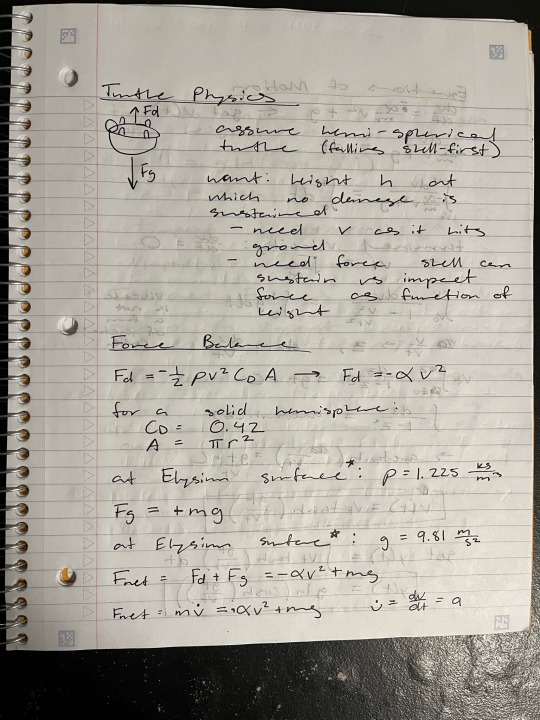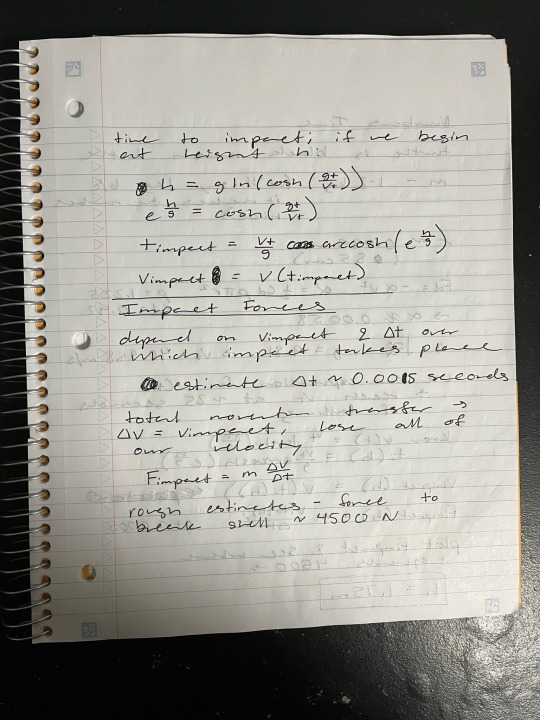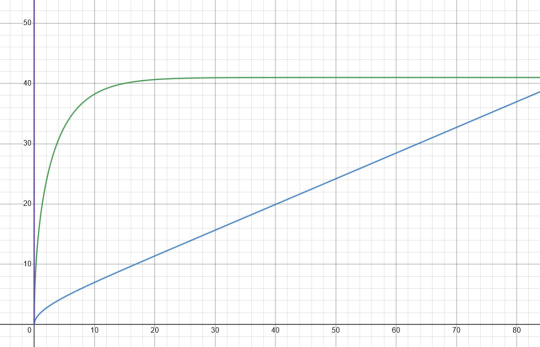#like I said on the falling turtle post: doing physics on elysium is a fucking Time
Explore tagged Tumblr posts
Note
Say, does quantum physics correlate with time traveling journey? Time traveling machine quite tempting to be made..
VISUAL CALCULUS [Heroic: Success] — Quantum physics actually has very little to do with our understanding of time, or the possibility of time travel. Most of the relevant theory falls under the theory of relativity, with a little bit of thermodynamics sprinkled in.
At its most basic level, relativity states that our reality exists in four dimensions: the three spatial dimensions we usually think of, and time, which is why we sometimes refer to it as "spacetime". Time is connected to the other three dimensions in a special way: the faster you move through space, the slower you move through time. Similarly, the closer you are to very massive object, such as a black hole or Elysium's core, the slower time passes for you.
This means that it is almost trivially easy to travel forward in time— just steal an aerostatic and fly very, very fast, or take a vacation at the bottom of the ocean. Either of these will cause you to experience less time than a friend who stays stationary or at sea level, so upon your return you will have effectively traveled to the future— by a few billionths of a second. A difference in elevation of a few thousand feet is not enough to create a significant difference in time, nor are there any means of transportation able to reach the necessary speeds to make this a practical means of time travel. But traveling forward is at least theoretically possible.
However, based on your prior interaction with Savoir Faire and Interfacing, I suspect that you are interested in traveling backwards, and I am afraid I need to be the bearer of bad news: it is simply impossible. The arrow of time only points forward. This is a law higher than you, or me, or Authority, or any of us. There is nothing we can do to reverse it, in any normal reality.
Physically, this is intrinsically linked to the idea of entropy, a measure of disorder. Entropy can never decrease— any process that is possible can only increase disorder, never decrease it. Reversing the flow of time and traveling backwards through it would allow you to increase order. For example, if you broke a glass, then traveled back to a time where the glass was whole again, you would be returning it to its ordered state, making backwards time travel impossible just from a physics standpoint. That doesn't even scratch the surface of the possible paradoxes of causality such travel would cause.
However. Not all of Elysium is part of our normal sense of reality. Entropy and entroponetic share the same root, after all— the Pale is entropy incarnate, disorder made manifest. Deep enough in the Pale, this disorder is great enough that our usual notions of time and space have no meaning. Reality ceases to have dimensions at all and the laws of physics break down.
The only way we can travel through the Pale at all is using Pale latitude compressors— devices that allow us to force the Pale into having dimensions again, taking on the shape of our familiar four-dimensional spacetime. No one has ever tried forcing the pale into being anything else. It's easy to see why— for transport of human beings, you want to make sure that they stay cocooned in a reality they can safely exist in. But, I do confess to having wondered whether it might be possible to use a Pale latitude compressor to impose a different type of reality on the Pale. If we're imposing dimensions anyway, perhaps it's possible to pick how they relate to each other such that traveling backwards in time is possible?
Please do note that I do not recommend that you try this, Turtle. Harry's brief encounter with the latitude compressor in Martinaise has more than convinced me that they are not to be trifled with. Additionally, there's no telling whether a set of dimensions that would allow time travel would also allow you to exist, or whether such a set would even exist at all. Most of us have come to like you quite a lot— I would hate to see you perish as a result of an entroponetic accident because you tried to time travel.
#skillsposting#ooc tags:#more high effort viscalcposting!#most of this is accurate up until the Pale stuff#there are a few conflicting theories about the nature of the arrow of time but the consensus is pretty firm that it only points forward#and most of the theories reduce to the second law of thermodynamics somehow#like I said on the falling turtle post: doing physics on elysium is a fucking Time#because the Pale is constantly just lurking in the background as an exception to any law of physics you might want to come up with#what do you MEAN there's no dimensions. that doesn't make any goddamn sense.#imagine my face when I realized pale latitude compressors might be able to allow faster than light travel#(by the same means as I described in the second to last paragraph- you might be able to pick dimensions where it's possible)#IDK if that actually works- I hate relativity and want to think about it as little as possible#<- I say as if my research isn't on something that's a direct consequence of general relativity. I am an unrepentant hypocrite.
12 notes
·
View notes
Note
ooc: call me encyclopedia because this post has footnotes- I wanted to go into more detail about the math and various simplifying assumptions I made, so look under the cut for those
"assume hemi-spherical turtle" is a reference to the common joke among physicists, "assume spherical cow". Unlike assuming spherical cows, hemispherical turtles make a slightly more reasonable approximation. Their shells are flatter and probably less aerodynamic, but it's close enough for my purposes.
Everything about deriving the equations for v(t) and y(t) are basically just the standard derivation for free-fall with quadratic drag. The integral involved is pretty schnasty and, despite running the visual calculus blog, I have very limited patience for calculus nonsense these days, especially for something I'm doing for fun and not my homework. So I ended up using a guide for most of it.
Most of the actual breaking bit I ended up pulling out of my ass. I wasn't lying when I said the physics of stuff breaking gets complicated— to do it out properly would probably require a computer simulation and a shitload of really complicated physics. A lot of a mechanical engineering degree is learning how stuff breaks (so you can make stuff that doesn't). I'm a physics student, not an engineering student, so it's physics I simply don't know and which doesn't interest me that much.
Impact time was pretty much just a guess— I assumed that the ideal impact for the turtle would be to bounce like a ball, which takes a few milliseconds. Anything else would require the shell to break, similar to the crumple zone on a car (side note: no crumple zones on motor carriages means Elysium cars are death traps), which slows down the momentum change and results in less overall force being applied. However, the shell breaking is exactly what we don't want. I originally tried 0.001 seconds, but that gave a laughably low height of 5cm, so I adjusted a little.
4500 Newtons is equivalent to 1000 pounds of force, which some sources said is enough to break a turtle shell. I have no clue how reliable that source is, however.
I think my answer of ~1 meter is fairly reasonable. Some turtle keepers report injuries from their turtles falling off of tables, which are about that high.
This last thing is purely just because it makes my little physics & astronomy brain go brrrr— I said that the acceleration due to gravity and the air density are the same as at the surface of the Earth, but labeled them as being the values for Elysium's surface. However, Elysium is likely a larger planet than Earth. We know that the shortest distance from Revachol to the edge of the Pale is ~6000km. If that means Insulinde is around 12,000km across, that's a third of the Earth's circumference right there. With seven isolas, all around that size, the part of the planet that's normal ground is probably larger than Earth. AND 73% of it is covered by the Pale. Needless to say, it should have a higher acceleration due to gravity and a higher air density at the surface. However, everything we see in the game is probably consistent with Elysium having Earth-like values for those parameters (I'm not about to go take pixel measurements of something falling to confirm that). so using these values is fine. probably.
Does gravity even work the same in Elysium??? Our best understanding of gravity is general relativity, which ties gravity pretty intrinsically to the coordinate system of a given area of space, and oh wait... the Pale doesn't have coordinates. Or dimensions. What the fuck do you mean, it doesn't have dimensions. These are the issues you run into when trying to suss out how physics works in Elysium: the Pale is a big old category error lurking around every corner, waiting to wreck your shit.
anyways... thank you Turtle for sending me this ask, I'm not sure what you want to know that for but you fully lobbed a meat-stuffed pumpkin into my enclosure that I got to bat around for a few days
anyways now back to your regularly scheduled viscalc posting
How tall do you think can I fall before my shell break by impact? Hypothetically in case
VISUAL CALCULUS [Formidable: Success] — It's difficult to pin down an exact number, given the necessary simplifications, but I can certainly come up with an estimate. Let me just...




To summarize, if we approximate your shell as a hemisphere, we can derive the equations for how fast and how far you would fall as a function of time, assuming you were dropped from rest and not thrown. With those equations in hand, we can then derive an expression for time of impact in terms of the height you were dropped from, and plug this in to our previous equation for velocity, to get your velocity at impact as a function of height. So far, so relatively accurate.
The difficult piece is determining the force of impact, and the force necessary to actually break your shell. The physics of how things break is messy, and while I can reconstruct objects the detective finds already broken, pre-constructing potential damage is much harder.
Our model is therefore somewhat simplistic— we take the force transferred to your shell upon impact to be the change in momentum divided by the time the impact takes. Since you go from impact velocity to zero velocity upon hitting the ground, the momentum change is simply your mass multiplied by your impact velocity. The time the impact takes is, admittedly, an educated guess on my part. We know it must be short, as lengthening it would require either padding on the ground your shell to break and slow you down gradually, which is the exact failure mode we're trying to avoid. We'll say it's about 0.005 seconds. We'll also say that it takes around 4500 Newtons of force to break your shell, and that your shell only breaks if the impact force exceeds this number. A more realistic model would take into account the possibility of varying degrees of damage, but again. Simplifying assumptions.
With all of these pieces, we can then plot the time of impact, impact velocity, and impact force as a function of drop height— shown in blue, green, and purple on the plot below.

Impact force increases incredibly quickly with drop height, so much so that it appears like a straight line on this plot. The purple curve crosses the 4500 Newton threshold at a mere 1.75 meters. Given the simplifying assumptions we've made, I'd say err on the side of caution and try not to fall a distance further than 1 meter without some manner of protective gear.
Please tell me you don't have any parachute-less skydiving trips planned...
#skillsposting-adjacent#everyone else's high-effort skillsposting: beautiful dialogues and prose#viscalc high-effort skillsposting: four pages worth of TURTLE MATH
13 notes
·
View notes